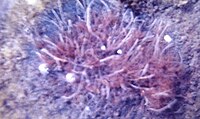Tubifex tubifex: Difference between revisions
No edit summary |
Reversing vandalism |
||
| Line 19: | Line 19: | ||
The worms can survive with little [[oxygen]] by waving [[hemoglobin]] rich tail-ends to exploit all available oxygen, they can also exchange carbon dioxide and oxygen through their thin skin, similar to frogs. They can also survive in areas heavily [[pollution|polluted]] with organic matter that almost no other species can endure. By forming a protective cyst and lowering its [[metabolic rate]], ''T. tubifex'' can survive drought and food shortage. [[Encystment]] may also function in the dispersal of the worm. |
The worms can survive with little [[oxygen]] by waving [[hemoglobin]] rich tail-ends to exploit all available oxygen, they can also exchange carbon dioxide and oxygen through their thin skin, similar to frogs. They can also survive in areas heavily [[pollution|polluted]] with organic matter that almost no other species can endure. By forming a protective cyst and lowering its [[metabolic rate]], ''T. tubifex'' can survive drought and food shortage. [[Encystment]] may also function in the dispersal of the worm. |
||
They usually inhabit the bottom sediments of [[lake]]s, [[river]]s, and occasionally [[sewage|sewer]] lines and outlets.<ref>{{cite web|url=http://www. |
They usually inhabit the bottom sediments of [[lake]]s, [[river]]s, and occasionally [[sewage|sewer]] lines and outlets.<ref>{{cite web|url=http://www.news14.com/content/local_news/triangle/611427/raleigh--sewer-creature--surprises-city-officials/Default.aspx|title=Raleigh 'sewer creature' surprises city officials|last=Dukes|first=Tyler|date=2009-07-01|publisher=news14.com|accessdate=2009-07-02}}</ref> |
||
==References== |
==References== |
||
Revision as of 19:43, 3 September 2010
| Tubifex tubifex | |
|---|---|

| |
| Scientific classification | |
| Kingdom: | |
| Phylum: | |
| Class: | |
| Order: | |
| Family: | |
| Genus: | |
| Species: | T. tubifex
|
| Binomial name | |
| Tubifex tubifex (Johannes Muller, 1774)
| |

Tubifex tubifex, also called the sludge worm, or sewage worm, is a species of tubificid segmented worm that inhabits the sediments of lakes and rivers on several continents. Tubifex probably includes several species, but distinguishing between them is difficult because the reproductive organs, commonly used in species identification, are resorbed after mating, and because the external characteristics of the worm vary with changes in salinity. These worms ingest sediments, selectively digest bacteria, and absorb molecules through the body wall.
The worms can survive with little oxygen by waving hemoglobin rich tail-ends to exploit all available oxygen, they can also exchange carbon dioxide and oxygen through their thin skin, similar to frogs. They can also survive in areas heavily polluted with organic matter that almost no other species can endure. By forming a protective cyst and lowering its metabolic rate, T. tubifex can survive drought and food shortage. Encystment may also function in the dispersal of the worm.
They usually inhabit the bottom sediments of lakes, rivers, and occasionally sewer lines and outlets.[1]
References
- ^ Dukes, Tyler (2009-07-01). "Raleigh 'sewer creature' surprises city officials". news14.com. Retrieved 2009-07-02.
| Lake zones |
|---|
| Lake stratification |
| Lake types |
| See also |
